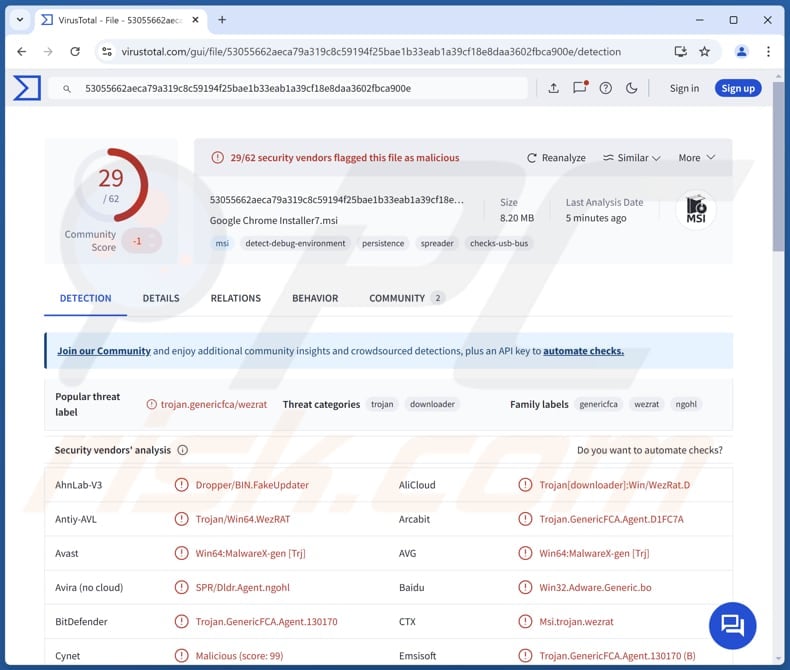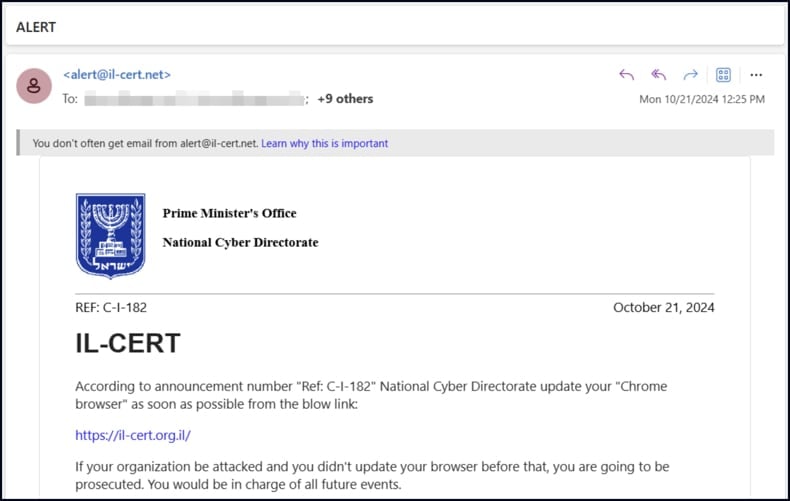How to remove WezRat malware from compromised systems
TrojanAlso Known As: WezRat information stealer
Get free scan and check if your device is infected.
Remove it nowTo use full-featured product, you have to purchase a license for Combo Cleaner. Seven days free trial available. Combo Cleaner is owned and operated by RCS LT, the parent company of PCRisk.com.
What kind of malware is WezRat?
WezRat is malware written in C++. Cybercriminals use it to steal information and perform other malicious activities. The malware has been active for over a year, with evolving modules and infrastructure. The latest version of WezRat was observed being distributed through deceptive emails.

More about WezRat
Once infiltrated, WezRat gathers system information, including the user profile path, local machine IP, computer name, and username. Some of this data is used to save additional modules on the infected system.
WezRat is capable of executing commands, uploading files, capturing screenshots, logging keystrokes, and stealing clipboard content and cookie files. Some of these tasks are handled by separate modules that are retrieved from the command and control (C&C) server.
Threat actors can use WezRat to capture the screen to gather sensitive information, monitor user activity and transfer files from the infected system to a remote server for data theft or further exploitation. Also, they can use it to log everything the victim types with a keyboard, including login credentials, credit card details, and other sensitive data.
Furhermore, the attackers can use the malware to access copied text, such as passwords or credit card numbers, for theft, and harvest cookies to hijack user sessions and gain unauthorized access to online accounts. Ovderall, WezRat is primarily designed for data theft.
| Name | WezRat information stealer |
| Threat Type | Informatio Stealer |
| Detection Names | Avast (Win64:MalwareX-gen [Trj]), Combo Cleaner (Trojan.GenericFCA.Agent.130170), ESET-NOD32 (A Variant Of Win64/WezRat.D), Kaspersky (Trojan.Win64.Agent.qwmkkr), Symantec (Trojan.Gen.MBT), Full List (VirusTotal) |
| Symptoms | Information stealers are designed to stealthily infiltrate the victim's computer and remain silent, and thus no particular symptoms are clearly visible on an infected machine. |
| Distribution methods | Infected email attachments, malicious online advertisements, social engineering, software 'cracks'. |
| Damage | Stolen passwords and banking information, identity theft, monetary loss, account takeover. |
| Malware Removal (Windows) |
To eliminate possible malware infections, scan your computer with legitimate antivirus software. Our security researchers recommend using Combo Cleaner. Download Combo CleanerTo use full-featured product, you have to purchase a license for Combo Cleaner. 7 days free trial available. Combo Cleaner is owned and operated by RCS LT, the parent company of PCRisk.com. |
Conclusion
In conclusion, WezRat is a malicious tool primarily used for data theft, enabling cybercriminals to steal sensitive information through various methods. As its capabilities continue to evolve, it poses a significant threat to individuals and organizations, underscoring the importance of strong cybersecurity measures to prevent such attacks.
How did WezRat infiltrate my computer?
Threat actors deliver WezRat through a fraudulent emails that impersonate the Israeli National Cyber Directorate (INCD). The email urges recipients to update their Chrome browser and includes a link to a fake website that looks like the legitimate INCD site.
Once users click the link, they automatically download a file called "Google Chrome Installer.msi", which contains both the Chrome installer and a backdoor file named Updater.exe. When executed, the backdoor connects to a remote server and ensures the malware stays active by adding itself to the registry.
Other popular methods for malware distribution include hiding malware in pirated software, using malicious advertisements, technical support scams, deceptive websites, software vulnerabilities, P2P networks, and similar channels.
How to avoid installation of malware?
Regularly update your operating system, browsers, and apps to patch security vulnerabilities. Always use official websites or app stores to download software and updates. Do not interact with ads, pop-ups, and links on untrustworthy websites. Avoid opening files or links in suspicious emails, especially when they are irrelevant/unexpected and from unknown senders.
Use reliable antivirus and anti-malware programs and keep them up to date. If you believe that your computer is already infected, we recommend running a scan with Combo Cleaner Antivirus for Windows to automatically eliminate infiltrated malware.
Fraudulent email distributing WezRat (source: checkpoint.com):

Instant automatic malware removal:
Manual threat removal might be a lengthy and complicated process that requires advanced IT skills. Combo Cleaner is a professional automatic malware removal tool that is recommended to get rid of malware. Download it by clicking the button below:
DOWNLOAD Combo CleanerBy downloading any software listed on this website you agree to our Privacy Policy and Terms of Use. To use full-featured product, you have to purchase a license for Combo Cleaner. 7 days free trial available. Combo Cleaner is owned and operated by RCS LT, the parent company of PCRisk.com.
Quick menu:
How to remove malware manually?
Manual malware removal is a complicated task - usually it is best to allow antivirus or anti-malware programs to do this automatically. To remove this malware we recommend using Combo Cleaner Antivirus for Windows.
If you wish to remove malware manually, the first step is to identify the name of the malware that you are trying to remove. Here is an example of a suspicious program running on a user's computer:

If you checked the list of programs running on your computer, for example, using task manager, and identified a program that looks suspicious, you should continue with these steps:
 Download a program called Autoruns. This program shows auto-start applications, Registry, and file system locations:
Download a program called Autoruns. This program shows auto-start applications, Registry, and file system locations:

 Restart your computer into Safe Mode:
Restart your computer into Safe Mode:
Windows XP and Windows 7 users: Start your computer in Safe Mode. Click Start, click Shut Down, click Restart, click OK. During your computer start process, press the F8 key on your keyboard multiple times until you see the Windows Advanced Option menu, and then select Safe Mode with Networking from the list.

Video showing how to start Windows 7 in "Safe Mode with Networking":
Windows 8 users: Start Windows 8 is Safe Mode with Networking - Go to Windows 8 Start Screen, type Advanced, in the search results select Settings. Click Advanced startup options, in the opened "General PC Settings" window, select Advanced startup.
Click the "Restart now" button. Your computer will now restart into the "Advanced Startup options menu". Click the "Troubleshoot" button, and then click the "Advanced options" button. In the advanced option screen, click "Startup settings".
Click the "Restart" button. Your PC will restart into the Startup Settings screen. Press F5 to boot in Safe Mode with Networking.

Video showing how to start Windows 8 in "Safe Mode with Networking":
Windows 10 users: Click the Windows logo and select the Power icon. In the opened menu click "Restart" while holding "Shift" button on your keyboard. In the "choose an option" window click on the "Troubleshoot", next select "Advanced options".
In the advanced options menu select "Startup Settings" and click on the "Restart" button. In the following window you should click the "F5" button on your keyboard. This will restart your operating system in safe mode with networking.

Video showing how to start Windows 10 in "Safe Mode with Networking":
 Extract the downloaded archive and run the Autoruns.exe file.
Extract the downloaded archive and run the Autoruns.exe file.

 In the Autoruns application, click "Options" at the top and uncheck "Hide Empty Locations" and "Hide Windows Entries" options. After this procedure, click the "Refresh" icon.
In the Autoruns application, click "Options" at the top and uncheck "Hide Empty Locations" and "Hide Windows Entries" options. After this procedure, click the "Refresh" icon.

 Check the list provided by the Autoruns application and locate the malware file that you want to eliminate.
Check the list provided by the Autoruns application and locate the malware file that you want to eliminate.
You should write down its full path and name. Note that some malware hides process names under legitimate Windows process names. At this stage, it is very important to avoid removing system files. After you locate the suspicious program you wish to remove, right click your mouse over its name and choose "Delete".

After removing the malware through the Autoruns application (this ensures that the malware will not run automatically on the next system startup), you should search for the malware name on your computer. Be sure to enable hidden files and folders before proceeding. If you find the filename of the malware, be sure to remove it.

Reboot your computer in normal mode. Following these steps should remove any malware from your computer. Note that manual threat removal requires advanced computer skills. If you do not have these skills, leave malware removal to antivirus and anti-malware programs.
These steps might not work with advanced malware infections. As always it is best to prevent infection than try to remove malware later. To keep your computer safe, install the latest operating system updates and use antivirus software. To be sure your computer is free of malware infections, we recommend scanning it with Combo Cleaner Antivirus for Windows.
Frequently Asked Questions (FAQ)
My computer is infected with WezRat malware, should I format my storage device to get rid of it?
Yes, formatting your storage device can remove WezRat, but it will also erase all your data. Thus, use a trusted antivirus program like Combo Cleaner to attempt removal first.
What are the biggest issues that malware can cause?
The most common and biggest issues include identity theft, financial loss, system damage, privacy invasion, and additional infections.
What is the purpose of WezRat?
The purpose of WezRat is primarily data theft. It collects sensitive information such as keystrokes, clipboard data, cookies, and system details, which cybercriminals can use for various malicious purposes.
How did WezRat infiltrate my computer?
WezRat likely infiltrated your computer through a phishing email with a fake Chrome update link. Clicking the link downloaded a malicious file that installed the malware.
Will Combo Cleaner protect me from malware?
Yes, Combo Cleaner can detect and remove most known malware infections. However, advanced malware often hides deep within the system, making a full system scan essential.
Share:

Tomas Meskauskas
Expert security researcher, professional malware analyst
I am passionate about computer security and technology. I have an experience of over 10 years working in various companies related to computer technical issue solving and Internet security. I have been working as an author and editor for pcrisk.com since 2010. Follow me on Twitter and LinkedIn to stay informed about the latest online security threats.
PCrisk security portal is brought by a company RCS LT.
Joined forces of security researchers help educate computer users about the latest online security threats. More information about the company RCS LT.
Our malware removal guides are free. However, if you want to support us you can send us a donation.
DonatePCrisk security portal is brought by a company RCS LT.
Joined forces of security researchers help educate computer users about the latest online security threats. More information about the company RCS LT.
Our malware removal guides are free. However, if you want to support us you can send us a donation.
Donate
▼ Show Discussion